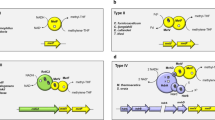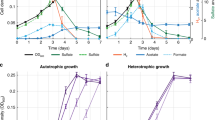Abstract
Desulfotomaculum acetoxidans has been proposed to oxidize acetate to CO2 via an oxidative acetyl-CoA/carbon monoxide dehydrogenase pathway rather than via the citric acid cycle. We report here the presence of the enzyme activities required for the operation of the novel pathway. In cell extracts the following activities were found (values in brackets=specific activities and apparent K m; 1 U·mg-1=1 μmol·min-1·mg protein-1 at 37°C): Acetate kinase (6.3 U·mg-1; 2 mM acetate; 2.4 mM ATP); phosphate acetyltransferase (60 U·mg-1, 0.4 mM acetylphosphate; 0.1 mM CoA); carbon monoxide dehydrogenase (29 U·mg-1; 13% carbon monoxide; 1.3 mM methyl viologen); 5,10-methylenetetrahydrofolate reductase (3 U·mg-1, 0.06 mM CH3−FH4); methylenetetrahydrofolate dehydrogenase (3.6 U·mg-1, 0.9 mM NAD, 0.1 mM CH2=FH4); methenyltetrahydrofolate cyclohydrolase (0.3 U·mg-1); formyltetrahydrofolate synthetase (3 U·mg-1, 1.4 mM FH4, 0.4 mM ATP, 13 mM formate); and formate dehydrogenase (10 U·mg-1, 0.4 mM formate, 0.5 mM NAD). The specific activities are sufficient to account for the in vivo acetate oxidation rate of 0.26 U·mg-1.
Similar content being viewed by others
Abbreviations
- FH4 :
-
Tetrahydrofolate
- CHO-FH4 :
-
N10-formyltetrahydrofolate
- CH≡FH4 :
-
N5,N10-methenyltetrahydrofolate
- CH2=FH4 :
-
N5,N10-methylenetetrahydrofolate
- CH3−FH4 :
-
N5-methyltetrahydrofolate
- MOPS:
-
morpholinopropane sulfonic acid
- DTT:
-
d,l-1,4-dithiothreitol
- TRIS:
-
tris-(hydroxymethyl)-aminomethane
- Ap5A:
-
p1,P5-di(adenosine-5′)pentaphosphate
- MV:
-
methyl viologen
References
Andreesen JR, Ljungdahl LG (1974) Nicotinamide adenine dinucleotide phosphate-dependent formate dehydrogenase from Clostridium thermoaceticum: purification and properties. J Bacteriol 120:6–14
Andreesen JR, Schaupp A, Neurauter C, Brown A, Ljungdahl LG (1973) Fermentation of glucose, fructose, and xylose by Clostridium thermoaceticum: effect of metals on growth yield, enzymes, and the synthesis of acetate from CO2. J Bacteriol 114:743–751
Andreesen JR, Ghazzawi EE, Gottschalk G (1974) The effect of ferrous ions, tungstate and selenite on the level of formate dehydrogenase in Clostridium formicoaceticum and formate synthesis from CO2 during pyruvate fermentation. Arch Microbiol 96:103–118
Blaut M, Gottschalk G (1982) Effect of trimethylamine on acetate utilization by Methanosarcina barkeri. Arch Microbiol 133:230–235
Bradford MM (1976) A rapid and sensitive method for the quantitation of microgram quantities of protein utilizing the principle of protein-dye binding. Anal Biochem 72:248–254
Brandis-Heep A, Gebhardt NA, Thauer RK, Widdel F, Pfennig N (1983) Anaerobic acetate oxidation to CO2 by Desulfobacter postgatei. 1. Demonstration of all enzymes required for the operation of the citric acid cycle. Arch Microbiol 136:222–229
Clark JE, Ljungdahl LG (1984) Purification and properties of 5,10-methylenetetrahydrofolate reductase, an iron-sulfur flavoprotein from Clostridium formicoaceticum. J Biol Chem 259:10845–10849
Clark JE, Ragsdale SW, Ljungdahl LG, Wiegel J (1982) Levels of enzymes involved in the synthesis of acetate from CO2 in Clostridium thermoautotrophicum. J. Bacteriol 151:507–509
Diekert G (1980) Kohlenmonoxid-Oxidation und die Reduktion von CO2 zu Acetat in Clostridien. Doctoral thesis, University of Marburg
Diekert GB, Thauer RK (1978) Carbon monoxide oxidation by Clostridium thermoaceticum and Clostridium formicoaceticum. J Bacteriol 136:597–606
Diekert G, Fuchs G, Thauer RK (1985) Properties and function of carbon monoxide dehydrogenase from anaerobic bacteria. In: Poole RK, Dow CS (eds) Microbial gas metabolism: mechanistic, metabolic and biotechnological aspects. Academic Press, London, pp 115–130
Eden G, Fuchs G (1983) Autotrophic CO2 fixation in Acetobacterium woodii. II. Demonstration of enzymes involved. Arch Microbiol 135:68–73
Eikmanns B, Thauer RK (1984) Catalysis of an isotopic exchange between CO2 and the carboxyl group of acetate by Methanosarcina barkeri grown on acetate. Arch Microbiol 138:365–370
Fischer R, Thauer RK (1988) Methane formation from acetyl phosphate in cell extracts of Methanosarcina barkeri: dependence of the reaction on coenzyme A. FEBS Lett 228:249–253
Fuchs G (1986) CO2 fixation in acetogenic bacteria: variations on a theme. FEMS Microbiol Rev 39:181–213
Gebhardt NA, Linder D, Thauer RK (1983) Anaerobic acetate oxidation to CO2 by Desulfobacter postgatei. 2. Evidence from 14C-labelling studies for the operation of the citric acid cycle. Arch Microbiol 136:230–233
Gebhardt NA, Thauer RK, Linder D, Kaulfers PM, Pfennig N (1985) Mechanism of acetate oxidation to CO2 with elemental sulfur in Desulfuromonas acetoxidans. Arch Microbiol 141:392–398
Jansen K, Thauer RK, Widdel F, Fuchs G (1984) Carbon assimilation pathways in sulfate reducing bacteria. Formate, carbon dioxide, carbon monoxide, and acetate assimilation by Desulfovibrio baarsii. Arch Microbiol 138:257–262
Kenealy WR, Zeikus JG (1982) One-carbon metabolism in methanogens: evidence for synthesis of a two-carbon cellular intermediate and unification of catabolism and anabolism in Methanosarcina barkeri. J Bacteriol 151:932–941
Kohler HPE, Zehnder AJB (1984) Carbon monoxide dehydrogenase and acetate thiokinase in Methanothrix soelngenii. FEMS Microbiol Lett 21:287–292
Laufer K, Eikmanns B, Frimmer U, Thauer RK (1987) Methanogenesis from acetate by Methanosarcina barkeri: catalysis of acetate formation from methyl iodide, CO2, and H2 by the enzyme system involved. Z Naturforsch 42c:360–372
Lee MJ, Zinder SH (1988) Isolation and characterization of a thermophilic bacterium with oxidizes acetate in syntrophic association with a methanogen and which grows acetogenically on H2-CO2. Appl Environ Microbiol 54:124–129
Leonhardt U, Andreesen JR (1977) Some properties of formate dehydrogenase, accumulation and incorporation of 185W-tungsten into proteins of Clostridium formicoaceticum. Arch Microbiol 115:277–284
Ljungdahl LG (1986) The autotrophic pathway of acetate synthesis in acetogenic bacteria. Annu Rev Microbiol 40:415–450
Ljungdahl LG, O'Brien WE, Moore MR, Liu MT (1980) Methylenetetrahydrofolate dehydrogenase from Clostridium formicoaceticum and methylentetrahydrofolate dehydrogenase, methenyltetrahydrofolate cyclohydrolase (combined) from Clostridium thermoaceticum. In: McCormick DB, Wright LD (eds) Methods in enzymology, vol 66. Academic Press, New York London, pp 599–609
Möller-Zinkhan D, Thauer RK (1988) Membrane-bound NADPH dehydrogenase-and ferredoxin: NADP oxidoreductase activity involved in electron transport during acetate oxidation to CO2 in Desulfobacter postgatei. Arch Microbiol (in press)
Möller D, Schauder R, Fuchs G, Thauer RK (1987) Acetate oxidation to CO2 via a citric acid cycle involving an ATP-citrate lyase: a mechanism for the synthesis of ATP via substrate level phosphorylation in Desulfobacter postgatei growing on acetate and sulfate. Arch Microbiol 148:202–207
Moore MR, O'Brien WE, Ljungdahl LG (1974) Purification and characterization of nicotinamide adenine dinucleotide-dependent methylenetetrahydrofolate dehydrogenase from Clostridium formicoaceticum. J Biol Chem 249:5250–5253
O'Brien WE, Ljungdahl LG (1972) Fermentation of fructose and synthesis of acetate from carbon dioxide by Clostridium formicoaceticum. J Bacteriol 109:626–632
O'Brien WE, Brewer JM, Lijungdahl LG (1973) Purification and characterization of thermostable 5,10-methylenetetrahydrofolate dehydrogenase from Clostridium thermoaceticum. J Biol Chem 248:403–408
Pfennig N, Widdel F, Trüper HG (1981) The dissimilatory sulfatereducing bacteria. In: Starr MP, Stolp, H, Trüper HG, Balows A, Schlegel HG (eds) The prokaryotes, vol I. Springer, Berlin Heidelberg New York, pp 926–940
Postgate JR (1984) The sulphate-reducing bacteria, 2nd edn. Cambridge University Press, Cambridge
Rabinowitz JC (1963) Preparation and properties of 5,10-methenyltetrahydrofolic acid and 10-formyltetrahydrofolic acid. In: Colowick SP, Kaplan NO (eds) Methods in enzymology, vol VI. Academic Press, New York London, pp 814–815
Rabinowitz JC, Pricer Jr WE (1962) Formyltetrahydrofolate synthetase. I. Isolation and crystallization of the enzyme. J Biol Chem 237:2898–2902
Ragsdale SW, Ljungdahl LG (1984) Purification and properties of NAD-dependent 5,10-methylenetetrahydrofolate dehydrogenase from Acetobacterium woodii. J Biol Chem 259:3499–3503
Savage MD, Wu Z, Daniel SL, Lundie Jr LL, Drake HL (1987) Carbon monoxide-dependent chemolitothrophic growth of Clostridium thermoautotrophicum. Appl Environ Microbiol 53:1902–1906
Schauder R, Eikmanns B, Thauer RK, Widdel F, Fuchs G (1986) Acetate oxidation to CO2 in anaerobic bacteria via a novel pathway not involving reactions of the citric acid cycle. Arch Microbiol 145:162–172
Schauder R, Widdel F, Fuchs G (1987) Carbon assimilation pathways in sulfate-reducing bacteria. II. Enzymes of a reductive citric acid cycle in the autotrophic Desulfobacter hydrogenophilus. Arch Microbiol 148:218–225
Schaupp A, Ljungdahl LG (1974) Purification and properties of acetate kinase from Clostridium thermoaceticum. Arch Microbiol 100:121–129
Sun AY, Ljungdahl L, Wood HG (1969) Total synthesis of acetate from CO2. II. Purification and properties of formyltetrahydrofolate synthetase from Clostridium thermoaceticum. J Bacteriol 98:842–844
Tanner RS, Wolfe RS, Ljungdahl LG (1978) Tetrahydrofolate enzyme levels in Acetobacterium woodii and their implication in the synthesis of acetate from CO2. J Bacteriol 134:668–670
Thauer RK (1982) Dissimilatory sulphate reduction with acetate as electron donor. Phil Trans R Soc Lond B 298:467–471
Thebrath B (1986) Biochemie der Sulfat-Aktivierung bei der Gattung Desulfotomaculum. Diploma thesis, University of Konstanz
Widdel F (1980) Anaerober Abbau von Fettsäuren und Benzoesäure durch neu isolierte Arten Sulfat-reduzierender Bakterien. Doctoral thesis, University of Göttingen
Widdel F (1988) Microbiology and ecology of sulfate-and sulfur-reducing bacteria. In: Zehnder AJB (ed) Environmental microbiology of anaerobes, chapt 10. John Wiley & Sons, New York London) (in press)
Widdel F, Pfennig N (1977) A new anaerobic, sporing, acetateoxidizing, sulfate-reducing bacterium, Desulfotomaculum (emend.) acetoxidans. Arch Microbiol 112:119–122
Widdel F, Pfennig N (1981a) Studies on dissimilatory sulfate-reducing bacteria that decompose fatty acids. I. Isolation of new sulfate-reducing bacteria enriched with acetate from saline environments. Description of Desulfobacter postgatei gen. nov., sp. nov. Arch Microbiol 129:395–400
Widdel F, Pfennig N (1981b) Sporulation and further nutritional characteristics of Desulfotomaculum acetoxidans. Arch Microbiol 129:401–402
Widdel F, Pfennig N (1984) Dissimilatory sulfate-or sulfur-reducing bacteria. In: Krieg NR, Holt JG (eds) Bergey's manual of systematic bacteriology, vol 1. Williams & Wilkins, Baltimore London, pp 663–679
Wood HG, Ragsdale SW, Pezacka E (1986) The acetyl-CoA pathway of autotrophic growth. FEMS Microbiol Rev 39:345–362
Zinder SH, Koch M (1984) Non-aceticlastic methanogenesis from acetate: acetate oxidation by a thermophilic syntrophic coculture. Arch Microbiol 138:263–272
Author information
Authors and Affiliations
Rights and permissions
About this article
Cite this article
Spormann, A.M., Thauer, R.K. Anaerobic acetate oxidation to CO2 by Desulfotomaculum acetoxidans . Arch. Microbiol. 150, 374–380 (1988). https://doi.org/10.1007/BF00408310
Received:
Accepted:
Issue Date:
DOI: https://doi.org/10.1007/BF00408310




